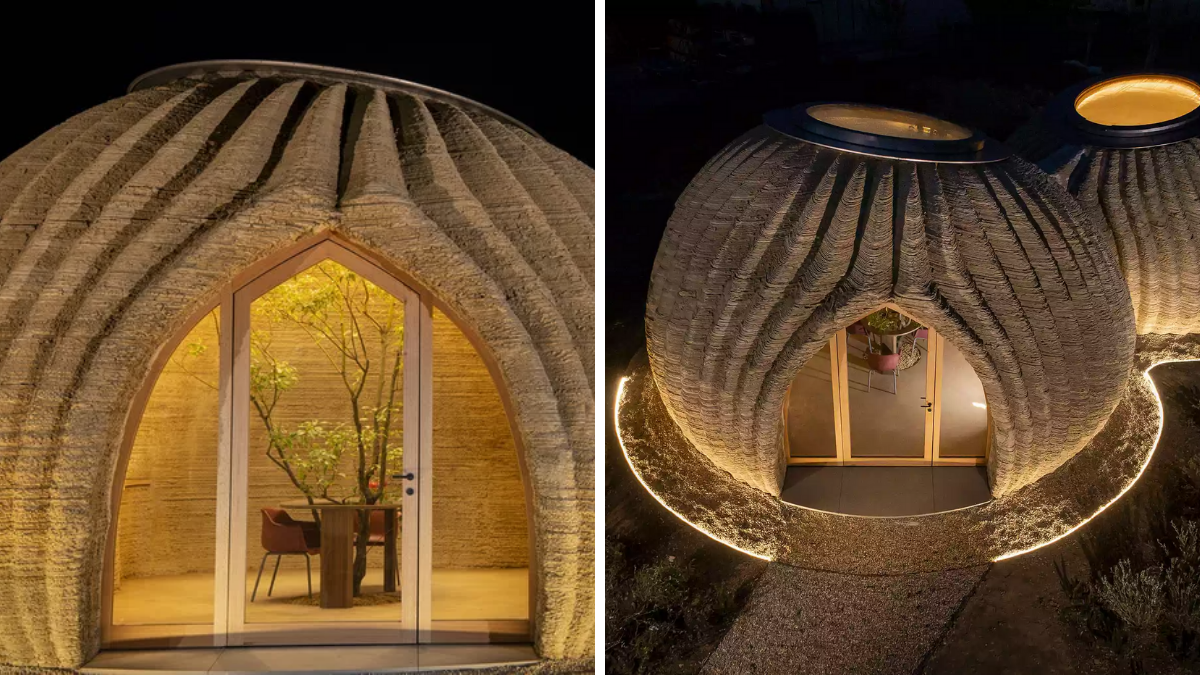How can architecture assist in solving the housing crisis and create a more sustainable future? Mario Cucinella Architects has produced a prototype for 3D printed homes west of Ravenna, Italy, in the small village of Massa Lombarda that tries to do both by integrating some of the latest tech with some of the oldest housing materials. The achievement, also called Tecla, was possible through a collaboration between architect Mario Cucinella and the World’s Advanced Saving Project (WASP).
Inspired by Italo Calvino’s ‘invisible cities’ – a metropolis in continuous development – the building comprises two circular, interconnected domes made of local materials and has nearly zero emissions. Soil from the area was utilized to produce its 350-layer walls, and its curved shell is fully biodegradable.
What is TECLA?
On the other hand, TECLA was built using soil found at the site mixed with water, fibers from rice husks, and a binder, the last of which Cucinella notes accounts for less than 5% of the total weight of the structure. Cucinella believes that this strategy may be repeated in many world regions using whatever local materials are available. It might be especially beneficial in underserved rural areas where industrial construction materials may be more challenging to come by.
Tradition Meets New Technology:
Cucinella pointed out that building homes out of the soil is not a new concept. Adobe, a composite of earth, water, and organic material, is one of the world’s oldest building materials, renowned for its durability, biodegradability, and natural insulation.
“The difficulty was genuinely combining an old material in architecture with new tech to produce a new shape of the house,” Cucinella explained.
To that purpose, Crane WASP printers blended water with local earth before layering the 60-square-meter (645-square-foot) TECLA prototype with a complicated latticework design. The design has two circular areas linked together by skylights that diffuse light onto the textured walls. The house has a bedroom, living room, and a bathroom. Its furnishings, such as tables and chairs, may also be printed using WASP’s gear, and components like doors and windows were added after printing.
However, the concept behind TECLA is not to copy the same home for every environment but to adapt the design depending on the location. “We are not making a single type of home that you can print and use anywhere… Of course, because, designing a house in the north of Italy, or… amid Africa, is not exactly the same, “Cucinella elaborated. “We modify the dwelling to suit different climates.”
Carbon-Neutral Objectives:
Cucinella believes that houses which are 3D printed in place with natural materials could be a valuable technological tool as Europe strives to achieve carbon neutrality by 2050. As per a 2020 report by the United Nations Environment Programme and the International Energy Agency, building and construction are responsible for 38% of global carbon emissions.
Cucinella claims that TECLA is low-waste since its shell is biodegradable (additional fittings such as doors and windows are not). As a result, the construction process requires significantly less energy than constructing an average home.
“When we talk about sustainability, I think we need to look about the construction process as well because construction procedures are quite energy-intensive and emit a lot of CO2 (carbon dioxide),” Cucinella said.
He believes that we can learn from pre-industrial architectural design to create environmentally friendly structures. “We can tap into the information of how architects were able to design infrastructures with no energy for most centuries if we go about the past,” he said.
What’s The Current Update?
The TECLA prototype is now being tested for structural and thermal performance, which is required before the technology can be scaled up. However, Cucinella said if it goes into production, he would happily live there because the materials inspire a sense of home and history.




